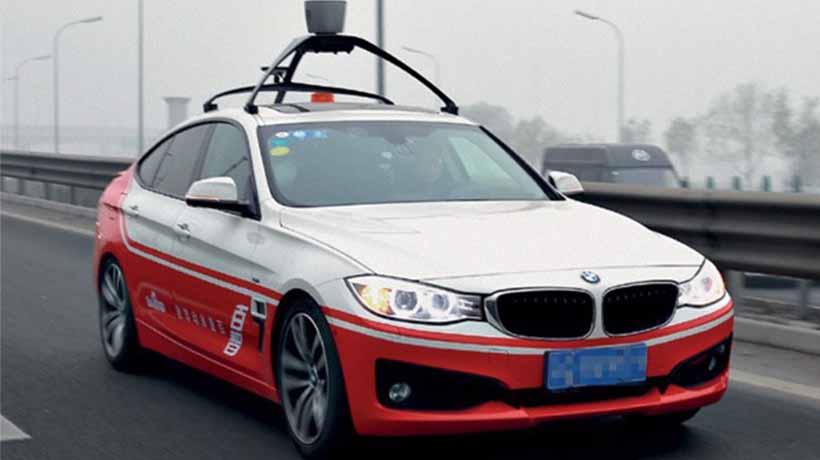Trending Now
- 830 voters names go missing in Kavundampalayam constituency
- If BJP comes to power we shall consider bringing back electoral bonds: Nirmala Sitaraman
- Monitoring at check posts between Kerala and TN intensified as bird flu gets virulent in Kerala
Technology
The rise of a science superpower
![]() February 10, 2018
February 10, 2018
Driverless cars that can survive nearly all accidents. Hospitals and restaurants that use face recognition software to access patients’ medical history and to order your favourite dish. Artificial Intelligence (AI) that guides a city’s traffic movements, predicts traffic congestion and even arranges bicycles for commuters. Intelligent applications that get approvals for bank loans faster than one can imagine. A ‘big brother’ surveillance that uses ‘big data’ to predict street crime and also tracks citizens’ movements using one of the most powerful face recognition programmes.
This isn’t a peep into an Orwellian future. This is today’s China. No country is moving faster than China in harnessing ‘big data’ and AI to power its industries-what most experts see as the next technological wave. In September last year, Beijing outlined a plan aimed at deploying AI technology across sectors-from education to transport. For China, AI is at the heart of its technological leap forward.
THE NEW ‘MADE IN CHINA’
For many in India, a ‘Made in China’ caricature that comprises fakes, cheap toys and electronics is widely pervasive. But in truth, Chinese manufacturing today is far removed from the “world’s factory” that drove Beijing’s export-led growth two decades ago. In Xian, for instance, robots have replaced workers in a factory that is churning out one of the world’s most advanced laser diodes. In Guizhou, China is building one of the world’s largest ‘big data’ facilities. In Beijing’s technological hub of Zhongguancun, internet companies that began as start-ups are now global behemoths. Of the top 10 biggest internet companies in the world by revenue, four are Chinese-e-commerce giants JD and Alibaba; Tencent, which is behind the social media app WeChat; and Baidu, which started as a search engine and is now leading the AI push, including in autonomous cars. In comparison, only one of India’s top IT companies is among the top 25-Flipkart. China has more than 700 million internet users-more than double of India’s.
China’s tech push is rapidly closing the gap with the United States of America. Alarmed by China’s strides, especially in AI, the Barack Obama administration had outlined a National Artificial Intelligence Research and Development Strategic Plan, which noted that the trends of AI research “reveal the increasingly global nature of research, with the US no longer leading the world in publication numbers”. That mantle has now gone to China. The US plan said that the impact of AI on society “will continue to increase, including on employment, education, public safety and national security, as well as the impact on US economic growth”.
“In algorithms, the gap between China and America is becoming smaller,” says Tu Zipei, a former president of Alibaba. “This is a big chance for China to become an AI leader,” adds Tu, pointing to how China, more than any other country, is best situated to make the next big tech leap. As he puts it, “data is the soil for AI to grow”.
THE WeCHAT GENERATION
The two biggest digital innovations in China at the centre of its data deluge have been Alibaba and Tencent’s WeChat, which has 1 billion users. Alibaba has transformed businesses, and WeChat is perhaps the most innovative social media platform in the world. It’s often wrongly described as a Chinese WhatsApp, but it’s far more advanced. In fact, it introduced voice and video calls years before WhatsApp did. It’s to some degree an amalgam of WhatsApp, Facebook and Paytm-users can post photographs, messages and use its e-wallet. In fact, this correspondent found that it’s possible to spend a day completely cashless in Beijing-from buying movie tickets and ordering taxis to paying electricity and gas bills with the touch of a fingerprint. “WeChat generates 100 million photos every day,” says Tu. “It’s only logical that Tencent develops the best face recognition technology in the world. And it will transform into an AI company eventually.”
THE AI RACE
Among the companies betting big on AI is Uisee in Beijing. It is developing autonomous cars. “We want to use AI and ‘big data’ to transform society,” says Wu Gansha, co-founder-CEO. “From traffic jams to accidents to air pollution to city layout, autonomous driving can do a lot to remove society’s problems. Our driverless cars are operating in Hangzhou without one accident in three months.” Wu is working with the government to take the Hangzhou experiment nationwide, and believes China is more bullish than the US. “I have been involved in several discussions with the Ministry of Industry and IT, and they believe that autonomous cars are an integral part of smart cities. China has planned 1,000 new towns by 2020. So we have the opportunity of having 1,000 new towns that are autonomous car-friendly,” Wu says.
Kaifu Lee, who earlier headed Google China and now runs Sinovation Ventures, an AI-focused investment firm, believes that China’s AI industry incentives are “world leading”. “If you are a credible venture capital fund setting up a fund in a region, the government will be a leading investor in your fund upto one-third. If you do well, you can buy back shares from the government. If you don’t, they subsidise your losses,” says Lee.
Lee adds that if the first wave was the internet, the second wave is “applying AI to businesses that have digitised data”, which China is pushing under its AI policy across every sector-from banking to healthcare to transport. The third wave, he says, is robotics and autonomous vehicles, where China is positioning itself to dominate.
THE NEW CHINESE WORKER
Robots have replaced workers on the assembly lines of Focuslight, a company in Xi’an, the ancient city famous for its terracotta warriors. The 10-year-old company manufactures advanced laser products used in industries ranging from space to information technology to life sciences. It’s a story that reflects China’s tech transformation.
China’s success in manufacturing is underpinning its moves in AI and other fields, where the ‘Made in China 2025′ plan envisages a revolution in smart manufacturing. Under the plan, China reached out to entrepreneurs like Focuslight founder Victor Liu, who, when he left Silicon Valley in 2006, was a reluctant returnee to his homeland. By then, China was a manufacturing behemoth, but was nowhere near the West when it came to innovation. Liu was part of the first batch of a government programme to bring back some of the talent that China, like India, had lost to the West.
However, where the two countries’ experiences differ is in Beijing’s determination to bring back this talent, demonstrated with action. Liu was told that he was required to innovate. He was offered a 10 million Yuan (Rs 10 crore) research fund, and a 1 million Yuan tax-free relocation package. Supported by the influential Chinese Academy of Sciences, he launched Focuslight, which would make advanced laser diodes, and in less than five years, begin to rival the American and European giants that Liu once worked for and become the third-most advanced firm in the world in its field. Focuslight serves as a poster of ‘Made in China 2025’, and a company emblematic of Made in China 2.0-high-tech manufacturing that Beijing hopes will replace the older export-driven Made in China of cheap goods.
“What people do not understand is manufacturing is key to innovation; manufacturing allows you to have an idea of how to design and produce a product,” Liu says. “I cannot emphasise enough how important the ecosystem, policy and administration are. It can make life difficult for you, whether taxes or something else, or it can be transformative.”
BIG BROTHER IS WATCHING
For China, building a digital state is being seen as a crucial weapon for the one-party regime to strictly maintain social control. In November last year, a video went viral showing a Chinese company’s face-recognition technology being used by the government-at a busy traffic intersection every passerby was identified by an ID number. The company, SenseFace, is deploying its technology in Beijing, Chongqing Guangdong, Sichuan and Hainan, and according to its CEO, it has caught 69 alleged criminals/ suspects in 40 days in one city. SkyNet is a nationwide system of millions of AI-powered cameras that watch streets, tracking traffic violations and crime. While the government says this will stop crime, it may also mean the end of privacy.
LESSONS FOR INDIA
In India, the impression that China can produce only cheap imitations is widespread. If anything, China’s story warns of the dangers of complacency in such assumptions. “I don’t think anyone would have foreseen 15 years ago that four of the 10 biggest internet companies would be Chinese,” says Kaiser Kuo, who worked with Baidu until 2016. Kuo says there is a misplaced perception that only China is blocking foreign competition to enable the rise of its giants. “Twitter was blocked in 2009, Google didn’t pull out until March 2010, but even by then these companies were far behind their competitors,” he says.
There are lessons from China’s digital economy that questionconventional wisdom on innovation, Kuo says. Even America’s story shows the importance of government in creating the right conditions. “The mythology of Silicon Valley forgetsthe extent to which defence department expenditures played a role. The internet is a primary example. The state has been smart in China in knowing when to get out of the way, in setting the tax policies, in encouraging recruitment, in putting in place the infrastructure and in bringing back the Chinese entrepreneurs.”
Shashank Reddy, who studies AI policy at Carnegie India, agrees. “In terms of data, India offers the same advantages as China-1.3 billion people have been enrolled in Aadhaar. The problem seems to be that nobody has managed to make use of these conditions. We don’t have a Google or Baidu that create the data you need to build a credible AI system. The history of the biggest technological innovations of our times shows there’s a lot of government backing and support that went into it,” he says.
The Union government appears to be listening. For the first time, the Union budget has specifically mentioned AI, robotics and machine learning, while the allocation for Digital India has been doubled to Rs 3,000 crore, though a detailed policy is still awaited. The importance of AI to national security is beginning to be realised, with the defence ministry announcing a new task force on employing AI for national security and defence needs on February 2. The task force brings together the private and public sectors, and will be chaired by N. Chandrasekaran of Tata Sons.Its members will include officials from the Defence Research and Development Organisation, government and educational institutions, IITs, and Reddy of Carnegie.
It is clear that the rise of digital China is changing conventional wisdom on what it takes to innovate. As Kuo puts it, “Indians, like Americans, have this idea that freedom of expression is a necessary condition for innovation to happen. What’s dangerous is if you think it’s a sufficient condition to make people innovate.” China is rewriting the rulebook, and India will ignore this transformation at its peril.
























